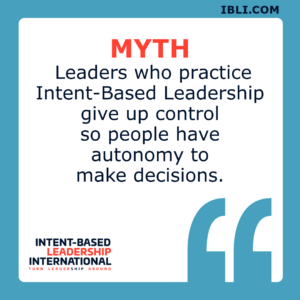
Our topic is the myth that leaders who practice Intent-Based Leadership give up control so people have autonomy to make decisions.
As we know words are important when it comes to leadership, and this is another great example.
Let’s get the easy part out of the way first. Leaders don’t give up control, they give more control.
Giving up control suggests abdicating any responsibility and involvement in decision-making, and that’s not how Intent-Based Leadership works. In fact, it’s probably the reason a lot of attempts to “empower” people go wrong. Because although empowerment is often synonymous with freedom, it is the absence of a structure to give people more control that often leads to failure.
The second important word here is autonomy. We associate autonomy with independence and freedom, and increased freedom is generally seen to be a positive thing.
In a team context, we need to be careful that autonomy does not mean people working independently of each other.
We worked with a fast growing business in England where people were hired specifically for their willingness to take authority and make decisions. We heard great examples of people being able to make decisions because they were close to the customer. But we also heard frustrations that people were finding out about actions colleagues had taken that impacted others’ work, and that there was generally a low level of learning because people had their heads down, focused on their own work and were not sharing their plans or what they were learning.
This is where Intent becomes so important.
When people share their intent, it increases communication and understanding. It is a mechanism for inviting feedback and further information. A strong team depends on people working and talking together, not operating independently of each other.